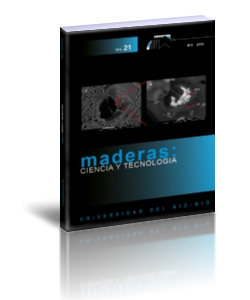Evaluation of wood surface coating performance using water based, solvent based and powder coating
Keywords:
Adhesion strength, coating hardness, coating thickness, medium-density fiberboard, surface hardnessAbstract
The objective of this study was to evaluate the surface coating performance using water base, solvent base and powder coating on medium density fiberboard. Samples were coated using water-base, solvent-base and powder coating. Coating performance was performed by using adhesion strength, surface coating hardness, layer thickness and rapid deformation test. The results were analyzed with two different statistical methods. Adhesion strength, layer thickness and surface hardness were determined by using ANOVA analysis, while results of rapid deformation test were analyzed by using Kruskal-Wallis method. According to these results, coating type was effective factor on the adhesion strength, surface coating hardness, layer thickness and rapid deformation test. Water-based painting application for adhesion strength and impact deformation resistance was higher than solvent-based coating. In the powder coating application, although surface coating hardness was higher than solvent and water base coating application, rapid deformation results were lower than solvent and water base coating applications. Adequacy of models was performed R-square (R²) and Adjusted R-square (Adj-R2) values. R2 values of adhesion strength, layer hardness and film layer thickness were 93.60 %, 95.33 % and 73.90 %, respectively. Adj-R2 values of adhesion strength, layer hardness and film layer thickness were 93.45 %, 95.23 % and 73.30 %, respectively.
Downloads
References
Ahola, P. 1991. Adhesion between paint and wood substrate. Surface Coatings International, 74(5);173–176.
Çakıcıer, N; Korkut, S; Korkut, D. 2011. Varnish layer hardness, scratch resistance, and glossiness of various wood species as affected by heat treatment. BioResource 6:1648-1658.
Cool, J; Hernández, R. E. 2011. Improving the sanding process of black spruce wood for surface quality and water-based coating adhesion. Forest Products Journal 61: 372–380.
Darmawan, W; Nandika, D; Noviyanti, E; Alipraja, I; Lumongga, D; Gardnes, D; Gerardin, P. 2017. Wettability and bonding quality of exterior coatings on japan and sengon wood surfaces. J. Coat. Technol. Res. DOI:10.1007/s11998-017-9954-1.
De Moura, L.F; Hernandez, R.E. 2006. Effects of abrasive mineral, grit size and feed speed on the quality of sanded surfaces of sugar maple wood. Wood Sci Technol 40: 517-530.
Dilik, T; Erdinler, S; Hazir, E; Koç, H; Hiziroglu, S. 2015. Adhesion strength of wood based composites coated with cellulosic and polyurethane paints. Advances in Materials Science and Engineering 1-5
Gurleyen, L; Ayata, U; Cakıcıer, N. 2017. Effect of heat treatment on the adhesion strength, pendulum hardness, surface roughness, color and glossiness of Scot pine laminated parquet with two different types of varnish application. Maderas-Cienc Tecnol 19(2):213-224.
Hernandez, R.E; Cool, J. 2008. Evaluation of three surfacing methods on paper birch wood relation to water and solvent borne coatings performance. Wood Fiber Sci 40(3):459-469.
ISO 4211-4. 2017. Furniture-Tests for surfaces-Part 4.Assesment of resistance to impact.
Jocham, C; Schmidt, T.W; Wuzella, G; Teischinger, A; Kandelbauer, A. 2011. Adhesion improvement of powder coating on medium density fiberboard (MDF) by thermal pre-treatment. Journal of Adhesion Science and Technology 25:1937-1946.
Keskin, H; Tekin, A. 2011. Abrasion resistance of cellulosic, synthetic, polyurethane, waterborne and acidhardening varnishes used woods. Construction and Building Materials 25(2):638-643
Landry, V; Blanchet, P. 2012. Surface preparation of wood for application of waterborne coatings. Forest Products Journal 62(2):39-45.
Landry, V; Blanchet, P; Cormier L.M. 2013.Water-based and solvent-based stains:Impact on the grain raising in Yellow Birch. BioResources 8(2):1997-2009.
Nejad, M; Cooper, P. 2011. Exterior wood coatings. Part-2: modeling correlation between coating properties and their weathering performance. Journal of Coatings Technology Research 8(4):459–467.
Nejad, M; Ung, T; Cooper, P. 2012. Effect of coatings on ACQ preservative component distribution and solubility after natural weathering exposure. Wood Sci Technol 46:1169-1180.
Ramananantoandro, T; Eyma, F; Belloncle, C; Rince, S; Irle, M. 2017. Effect of machining parameters on raised grain occurring after the application of water-based finishes. European Journal of Wood and Wood Products DOI 10.1007/s00107-017-1250-3.
Rield, B; Angle, C; Pregent, J; Blanchet, P; Stafford, L. 2014. Effect of wood surface modification by atmospheric-pressure plasma on waterborne coating adhesion. BioResources 9(3):4908-4923.
Salca, E.A; Krystofiak, T; Lis, B. 2017. Evaluation of selected properties of Alder wood as functions of sanding and coating. Coatings Doi:10.3390/coatings7100176.
Salça, E.A; Krystofiak, T; Lis, B; Mazela, B; Proszyk, S. 2012. Some coating properties of black alder wood as function of varnish type and applications method. BioResources 7: 5448-5459.
Sogutlu, C; Nzokou, P; Koc, Ismail; Tutgun, R; Döngeş, N. 2016. The effect of surface roughness on varnish adhesion strength of wood materials. Journal of Coating Technology and Research 13(5):863-870.
TS EN ISO 1522. 2016. Paints and Varnishes-Pendulum Damping Test. Turkish Standards Institution, Ankara, Turkey.
TS EN ISO 4624. 2016. Paints and Varnishes-Pull of test for adhesion. Turkish Standards Institution, Ankara, Turkey.

































